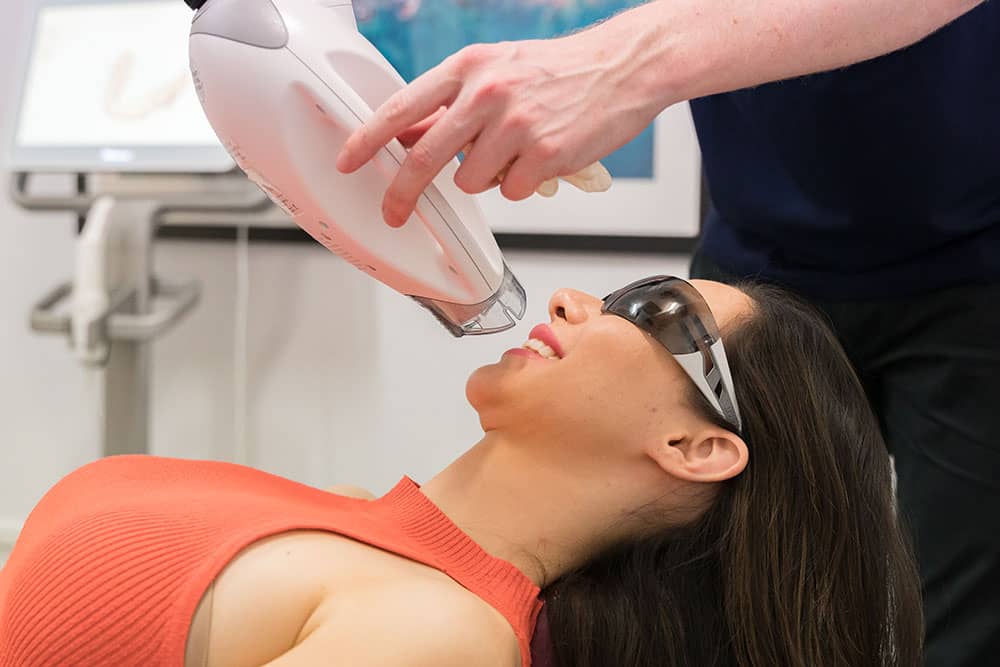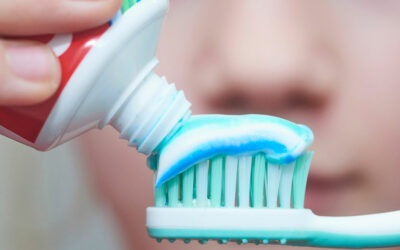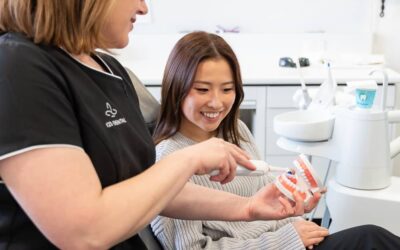Do you find yourself wishing for a brighter, whiter, healthier-looking smile? Stained teeth are a common concern our patients bring up.
Fortunately, having a whiter smile is achievable through a proper oral hygiene routine, teeth whitening (either at home or through a professional treatment), and limited exposure to stain-causing foods and drinks.
Here, we’ll cover the causes of teeth staining, how to prevent yellow teeth, the types of teeth staining, teeth whitening treatments, and foods and drinks to avoid for a bright smile.
What Are the Types of Tooth Discolouration?
Teeth stains can be categorised into three types:
- Extrinsic Stains – This type of staining occurs on the enamel (outer layer) of the teeth. It is caused by certain drinks, foods, and smoking. Extrinsic stains can often be removed through a good oral hygiene routine that includes consistent brushing, flossing, and whitening toothpaste.
- Intrinsic Stains – Intrinsic teeth staining occurs below the tooth’s surface (dentin). This type of staining has a number of causes such as overexposure to fluoride as a child, trauma, smoking, certain medications, and foods and drinks.
- Age-related Stains – Age-related stains are a result of a mix of intrinsic and extrinsic factors that occur naturally with age. Enamel weakens over time, causing the naturally darker colour of the dentin to be able to show through. Any nerve damage caused by oral inures or trauma can also contribute to discolouration of the teeth.
What Causes Stained Teeth?
Now that we’ve covered the different types of tooth staining, we’ll take a deeper look at the causes of stained teeth. Here are the main factors that contribute to discoloured teeth.
- Foods
- Vibrantly coloured fruits and berries such as blackberries, blueberries, pomegranates, cherries, and fruit juices
- Lollies that change the colour of your mouth or are hard
- Any candies or ice creams that change the colour of the inside of your mouth
- Sauces with deep colours such as tomato, pasta, curry, or soy sauces
- Drinks
- Black tea and other dark teas
- Herbal or white teas, although not richly coloured, can wear away the enamel of teeth
- Coffee
- Red wine (due to its dark colour and acidity)
- White wine (high acidic levels can damage enamel)
- Fizzy drinks (the acidity and high sugar content contribute to wear, plaque, and staining)
- Energy or sports drinks
- Poor Oral Hygiene Habits
- Poor oral hygiene promotes plaque and tartar build-up
- Plaque and tartar build-up can cause brown stains
- Tooth decay can also cause small dark holes to appear on teeth
- Medications
- Radiation or chemotherapy
- Medications for high blood pressure
- Overexposure to fluoride as a young child
- Tetracycline antibiotics before age 8
- A mother who used tetracycline antibiotics during the second half of her pregnancy
- Smoking and All Forms of Tobacco
- Nicotine promotes staining on the outer layer of teeth
- The nicotine and tar in chewing tobacco is easily absorbed by the pores in teeth and leads to staining
- Trauma
- Physical trauma that damages nerves in the teeth, such as cracked or chipped teeth
Tips for Preventing Tooth Discolouration
- Brush your teeth at least twice a day and especially after any foods or drinks that promote staining
- If you can’t brush your teeth right away after consuming a stain-causing food or drink, rinse your mouth with water
- Avoid or limit foods and drinks that contribute to tooth staining
- Drink with a straw if you are consuming juice, tea, ice coffee, or fizzy drinks
- Don’t let stain-promoting drinks and foods linger in your mouth
- Quit smoking
- Opt for healthy foods that do not promote staining such as melons, grapes, apples, and cauliflower
How To Prevent Coffee Stains on Teeth
- Drink coffee with a straw
- Avoid added sugar in your coffee
- Rinse your mouth with water after having coffee
- Wait a few minutes after having coffee and then brush your teeth (this will help prevent the acid from getting stuck to teeth and weakening the enamel)
How Can I Whiten My Teeth?
There are a variety of effective options for whitening teeth, both professionally and at home. Home whitening treatments include practicing good oral hygiene, whitening strips, bleaching gels, and using an antibacterial mouthwash.
You can also seek out professional teeth whitening if your stains are serious or have not responded to home treatment. Professional teeth whitening is a common cosmetic dental treatment involving a bleaching agent and a light-activated bleaching gel. This procedure can easily and quickly result in dramatically whiter teeth.
For severe or stubborn stains, several professional whitening treatments may be needed for optimal results.
Extrinsic stains typically respond well to whitening treatment, whereas intrinsic stains can be more stubborn. If stains do not respond to treatment, veneers may be an option worth discussing with your dentist.
Are You Interested in Teeth Whitening?
If you have been wondering how to whiten your smile, we offer a variety of teeth whitening solutions and would be happy to go over all the options with you.
Whether you want a whitening kit for home use, a professional whitening treatment at our office, or simply want to know our favourite whitening kinds of toothpaste, please feel free to reach out to us. We can also discuss the option of veneers if your staining is especially stubborn.








